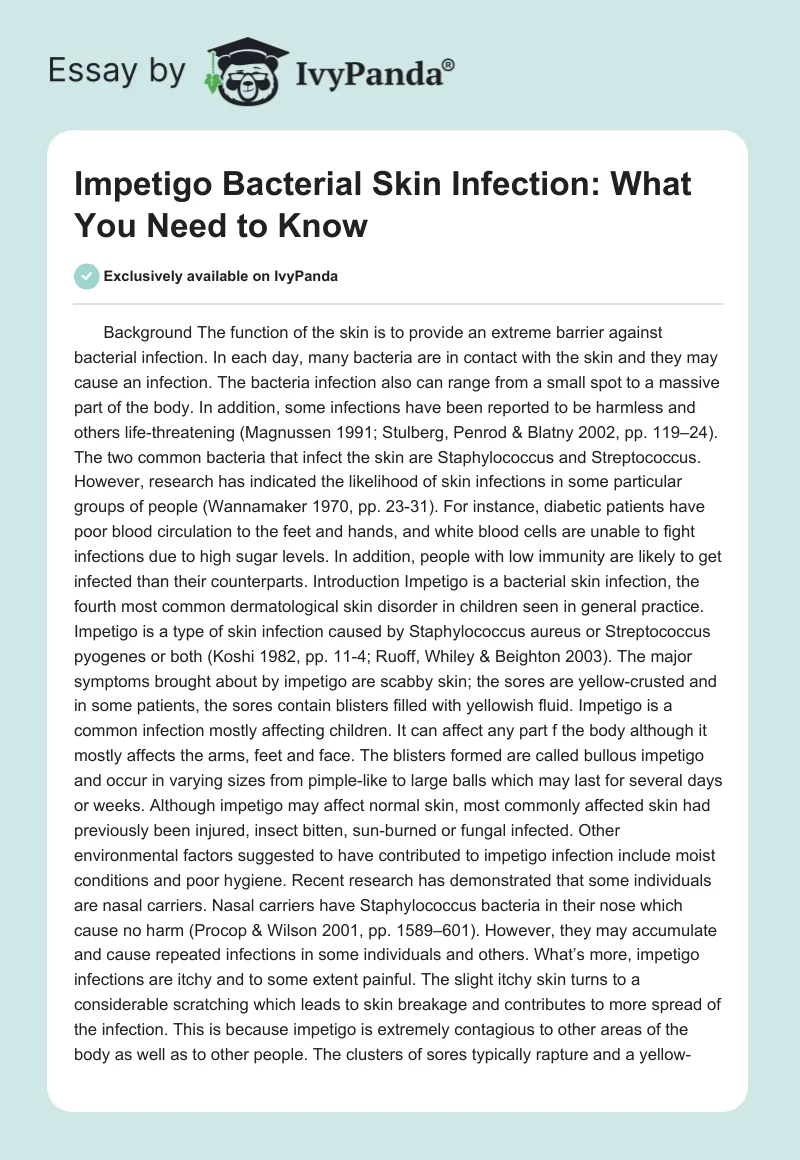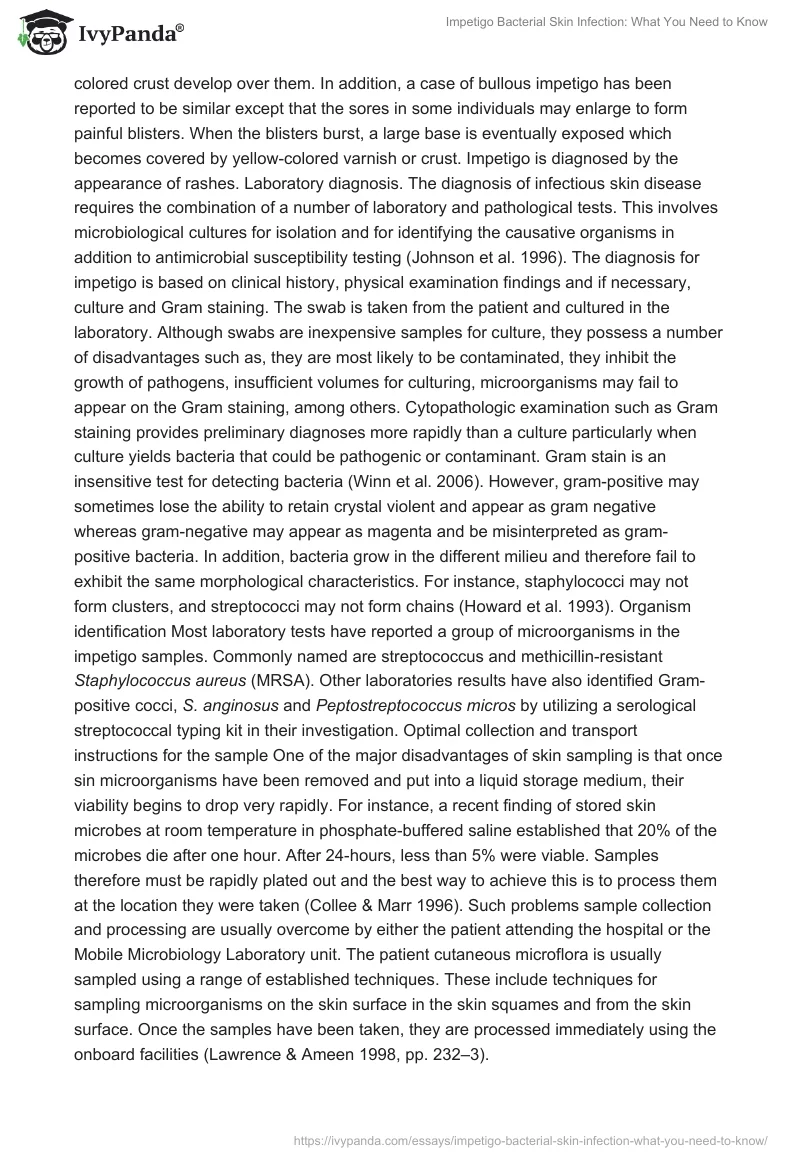Background The function of the skin is to provide an extreme barrier against bacterial infection. In each day, many bacteria are in contact with the skin and they may cause an infection. The bacteria infection also can range from a small spot to a massive part of the body. In addition, some infections have been reported to be harmless and others life-threatening (Magnussen 1991; Stulberg, Penrod & Blatny 2002, pp. 119–24). The two common bacteria that infect the skin are Staphylococcus and Streptococcus. However, research has indicated the likelihood of skin infections in some particular groups of people (Wannamaker 1970, pp. 23-31). For instance, diabetic patients have poor blood circulation to the feet and hands, and white blood cells are unable to fight infections due to high sugar levels. In addition, people with low immunity are likely to get infected than their counterparts. Introduction Impetigo is a bacterial skin infection, the fourth most common dermatological skin disorder in children seen in general practice. Impetigo is a type of skin infection caused by Staphylococcus aureus or Streptococcus pyogenes or both (Koshi 1982, pp. 11-4; Ruoff, Whiley & Beighton 2003). The major symptoms brought about by impetigo are scabby skin; the sores are yellow-crusted and in some patients, the sores contain blisters filled with yellowish fluid. Impetigo is a common infection mostly affecting children. It can affect any part f the body although it mostly affects the arms, feet and face. The blisters formed are called bullous impetigo and occur in varying sizes from pimple-like to large balls which may last for several days or weeks. Although impetigo may affect normal skin, most commonly affected skin had previously been injured, insect bitten, sun-burned or fungal infected. Other environmental factors suggested to have contributed to impetigo infection include moist conditions and poor hygiene. Recent research has demonstrated that some individuals are nasal carriers. Nasal carriers have Staphylococcus bacteria in their nose which cause no harm (Procop & Wilson 2001, pp. 1589–601). However, they may accumulate and cause repeated infections in some individuals and others. What’s more, impetigo infections are itchy and to some extent painful. The slight itchy skin turns to a considerable scratching which leads to skin breakage and contributes to more spread of the infection. This is because impetigo is extremely contagious to other areas of the body as well as to other people. The clusters of sores typically rapture and a yellow-colored crust develop over them. In addition, a case of bullous impetigo has been reported to be similar except that the sores in some individuals may enlarge to form painful blisters. When the blisters burst, a large base is eventually exposed which becomes covered by yellow-colored varnish or crust. Impetigo is diagnosed by the appearance of rashes. Laboratory diagnosis. The diagnosis of infectious skin disease requires the combination of a number of laboratory and pathological tests. This involves microbiological cultures for isolation and for identifying the causative organisms in addition to antimicrobial susceptibility testing (Johnson et al. 1996). The diagnosis for impetigo is based on clinical history, physical examination findings and if necessary, culture and Gram staining. The swab is taken from the patient and cultured in the laboratory. Although swabs are inexpensive samples for culture, they possess a number of disadvantages such as, they are most likely to be contaminated, they inhibit the growth of pathogens, insufficient volumes for culturing, microorganisms may fail to appear on the Gram staining, among others. Cytopathologic examination such as Gram staining provides preliminary diagnoses more rapidly than a culture particularly when culture yields bacteria that could be pathogenic or contaminant. Gram stain is an insensitive test for detecting bacteria (Winn et al. 2006). However, gram-positive may sometimes lose the ability to retain crystal violent and appear as gram negative whereas gram-negative may appear as magenta and be misinterpreted as gram-positive bacteria. In addition, bacteria grow in the different milieu and therefore fail to exhibit the same morphological characteristics. For instance, staphylococci may not form clusters, and streptococci may not form chains (Howard et al. 1993). Organism identification Most laboratory tests have reported a group of microorganisms in the impetigo samples. Commonly named are streptococcus and methicillin-resistant Staphylococcus aureus (MRSA). Other laboratories results have also identified Gram-positive cocci, S. anginosus and Peptostreptococcus micros by utilizing a serological streptococcal typing kit in their investigation. Optimal collection and transport instructions for the sample One of the major disadvantages of skin sampling is that once sin microorganisms have been removed and put into a liquid storage medium, their viability begins to drop very rapidly. For instance, a recent finding of stored skin microbes at room temperature in phosphate-buffered saline established that 20% of the microbes die after one hour. After 24-hours, less than 5% were viable. Samples therefore must be rapidly plated out and the best way to achieve this is to process them at the location they were taken (Collee & Marr 1996). Such problems sample collection and processing are usually overcome by either the patient attending the hospital or the Mobile Microbiology Laboratory unit. The patient cutaneous microflora is usually sampled using a range of established techniques. These include techniques for sampling microorganisms on the skin surface in the skin squames and from the skin surface. Once the samples have been taken, they are processed immediately using the onboard facilities (Lawrence & Ameen 1998, pp. 232–3).
The swab suspension is spiral plated using the WASP system onto a range of media that are selective for micro-organisms. To culture propionibacteria a Reinforced Clostridial Agar is used whereas Iso-Sensitest Agar is used for coagulase-negative staphylococci. In addition, Malassezia furfur medium has been formulated for the yeast. These plates are incubated for appropriate time Malassezia furfur (14 days), propionibacteria (7 days) and coagulase-negative staphylococci (48 hours). After incubation, a total viable count is carried out using techniques such as the Protocol automated colony counter (Okano Noguchi & Matsumoto 2000, pp. 942-4). Finding’s report An impetigo analysis was studied through clinical data and microorganisms samples collected from a given number of patients with the disease (Mathai & Thomas 2006, pp. 46-8). After sample culturing, the patients are usually grouped in accordance with their different skin cultures. A certain percent will be reported to have S. aureus-positive skin culture or bullous and non-bullous impetigo isolates. Nasal carriers are also categorized as well as Methicillin-resistant S. aureus (Kaplan & Wannamaker 1974, pp. 205-8). This kind of data report is important to doctors to understand the most prevalent infection and to determine key preventions. Treatment If a person is suspected to have repeated infections, a scrub of the nose is taken and checked in the laboratory if the person is a nasal carrier of staphylococci. Care should be taken at the infected areas. People are advised to wash the infected places gently with soaps and water numerous times a day in order to remove the crusts. Generally, topical antibiotics have been used to treat small infected areas (Dobie & Gray 2004, pp. 74-7). On the other hand, if large areas are to be treated, oral antibiotics have responded positively. Nasal carriers are usually treated by spreading topical antibiotics to the nasal passages. Since impetigo is contagious, the school nurse is greatly concerned with this infectious disease. A child may be required to leave school until he or she is treated (Koning & van-der Wouden 2004, pp. 695-6). For the individual patient, impetigo is a minor disease as a cure can be expected within weeks with most treatments. In developed countries, serious complications such as acute glomerulonephritis are rare. Recent research has suggested that treatment of impetigo with topical antibiotics is at least more effective than treatment with oral antibiotics. However, a considerable threat has been imposed on the resistance rates of Staphylococcus aureus against fusidic acid (topical antibiotic) and calls for its prudent use (Woodhead, Fleming & Wise 2004; Espersen 1998, pp. 4-8).
Conclusion Most medical organizations offer mobile test trials to patients which make treatments effective the skin diseases. The new treatments for impetigo concentrate on reducing or removing these bacteriological from the skin surface (Stevens 1992, pp. 2 -13). Clinical trials for novel drugs are applied to human skin since they contain unique features absent in animal skin. Healing of impetigo is expected if an appropriate antibiotic is used between 7 to 10 days. However, cases of antibiotic-resistant strain are becoming common and therefore alternative therapy should be used. Moreover, one way of preventing impetigo is by keeping the skin clean especially around rashes or wound areas. Also, avoid touching other areas of your body to lessen spread as well as sharing personal items like towels.
References
- Collee, J. & Marr, W. 1996, ‘Specimen collection, culture containers and media’, In : Mackie & McCartney Practical Medical Microbiology, Collee JG, Fraser AG, Marmion BP, Simmons A. editors. Churchill Livingstone: Edinburgh, p. 103
- Dobie, D. & Gray, J. 2004, ‘Fusidic acid resistance in Staphylococcus aureus’, Archives of Disease in Childhood, vol. 89, no.1, pp. 74-7.
- Espersen, F. 1998, ‘Resistance to antibiotics used in dermatological practice’, British Journal of Dermatology, vol. 139, no. 53, pp. 4-8.
- Howard, B. et al. 1993, Streptococci and related organisms, In Clinical and Pathogenic Microbiology, 2nd edn. Mosby Co. St. Louis, MO. James, D., Berger, H., Timothy, G. et al. 2006, ‘Andrews’ Diseases of the Skin’, Clinical Dermatology, Saunders Elsevier
- Johnson, D. R., Kaplan, E.L., Sramek, J. et al. 1996, Laboratory diagnosis of group A streptococcal infections, World Health Organization, Geneva.
- Kaplan, E. & Wannamaker, L. W. 1974, ‘Streptolysin O. Suppression of its antigencity by lipids extracted from skin’, The Society for Experimental Biology and Medicine, vol. 147, no. 2, pp. 205-8 Koning, S., & van-der Wouden, J. 2004, ‘Treatment for impetigo’, British Medical Journal, vol. 329, no. 2, pp. 695-6.
- Koshi, G. 1982, ‘Microbiological confirmation of streptococcal pharyngitis’, ICMR Bull, vol. 12, no. 2, pp. 11-4
- Lawrence, C. & Ameen, H. 1998, ‘Swabs and other sampling techniques’, Journal of Wound Care, vol. 7, pp. 232–3
- Magnussen, R. 1991, Skin and soft tissue infections, In RE Resse, RF Betts (edn.) A Practical Approach to Infectious Diseases 3 edn. Little, Brown and Company, Boston, MA. Mathai, E. & Thomas, C. 2006, ‘Interpretation of Bacterial Culture and Antimicrobial Susceptibility Reports’, Indian Journal for the Practicing Doctor, Vol. 3, No. 4, pp. 46-8. Okano, M., Noguchi, S. & Matsumoto, Y. 2000, ‘Topical gentian violet for cutaneous infections and nasal carriers with MRSA’, International Journal of Dermatology, vol. 39, no. 2, pp. 942-4
- Procop, G. & Wilson, M. 2001, ‘Infectious disease pathology’, Journal Clinical Infectious Diseases, vol. 32, pp. 1589–601.
- Ruoff, K., Whiley, R. & Beighton, D. 2003, Streptococcus, In PR Murray, et al (edn.), Manual of Clinical Microbiology, 8 edn., American Society for Microbiology, Washington, D.C.
- Stevens, D. 1992, ‘Invasive group a streptococcus infections’, Journal Clinical Infectious Diseases, vol. 14, no. 1, pp. 2 -13. Stulberg, D., Penrod, M. & Blatny, R. 2002, ‘Common bacterial skin infections’, American family physician, vol. 66, no. 1, pp. 119–24
- Wannamaker, L. 1970, ‘Differences between streptococcal infections of the throat and skin’, New England Journal of Medicine, vol. 282, no. 1, pp. 23-31.
- Winn, W., Allen, S. D., Janda, W. et al. 2006, Koneman’s color atlas and textbook of diagnostic microbiology, 6 edn, J.B. Lippincott, Philadelphia.
- Woodhead, M., Fleming, D. & Wise, R. 2004, ‘Antibiotics, resistance and clinical outcomes’, British Medical Journal, vol. 328, pp. 1270-1.


